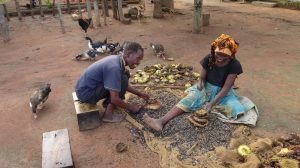Kikimbu: Documenting nomadism in Central Tanzania

Landing page image for the collection “Kikimbu: Documenting nomadism in Central Tanzania”. Click on image to access collection.
| Language | Kimbu (ISO639-3:kiv) |
| Depositor | Augustino Kagwema |
| Affiliation | Mkwawa University College of Education |
| Location | Tanzania |
| Collection ID | 0619 |
| Grant ID | SG0583 |
| Funding Body | ELDP |
| Collection Status | Collection online |
| Landing Page Handle | http://hdl.handle.net/2196/e7c73780-ae56-480b-b7b6-54f5f5dff6e2 |
Summary of the collection
Kimbu is a Bantu, Niger-Congo language spoken across a wide swathe of central Tanzania by loosely-associated communities totaling no more than 62,672 (Muzale and Rugemalira 2008). Sharply decreasing numbers, sparsely-distributed population, and largely negative attitudes of speakers toward speaking Kimbu (Simons and Fenig 2018, Gabriel 2018) mean that this language is highly endangered. Additionally, there are no documentary materials available for this language whatsoever. This small project provides an initial documentation of this language by focusing on a unique aspect of Kimbu culture: nomadism. Audiovisual recordings cover political economy, patterns of movement, and family structure and inheritance – all pertaining to how the Kimbu people move and have moved across the land. These materials, along with morphosyntactic and lexical elicitation, will be the starting point for grammatical analysis of the language.
Group represented
The Kimbu speaking community is scattered in different areas of Tanzania, some speakers are found in Manyoni (Singida), some in Sikonge (Tabora) and some in Kipambawe ward, Chunya (Mbeya). Shorter (1968) describes Kimbu community area as heavily wooded with many rivers, covering about 20,000 miles. However, most of the areas are set by the government as game or forest reserves, thus are not accessible for the community use. Under this circumstance, the Kimbu semi-nomadic way of life is in jeopardy since most of the areas are now restricted by the government. Traditionally, Kimbu community was divided into 38 chiefdoms which were grouped into four major groups: Nyisamba, Nyitumba, Nyangwila and Nyapito. Intriguingly all these chiefdoms had different origins and they were organized as such. Shorter (ibid) further confirms that all these groups forming Kimbu society were nomadic in nature and that they engaged in a wide range of activities like hunting and gathering, livestock keeping, nomadic farming and iron smelting.
Language information
Kimbu is a Bantu, Niger-Congo language spoken across a wide swathe of central Tanzania by loosely-associated communities totaling no more than 62,672 (Muzale and Rugemalira 2008). Sharply decreasing numbers, sparsely-distributed population, and largely negative attitudes of speakers toward speaking Kimbu (Simons and Fenig 2018, Gabriel 2018) mean that this language is highly endangered. Additionally, there are no documentary materials available for this language whatsoever. Kimbu has been placed in Guthrie’s F-group, but until lexical material is collected, this is an unproven hypothesis. It is Identified as one of the possible 13 languages to have taken part in contact in the hypothesized area (by areal linguists).
Collection contents
40 hours of audio data
20 hours of video data
Collection history
The materials in this collection where collected by Augustino Kagwema during the research for his ELDP-funded Small Grant in 2020.
Acknowledgement and citation
To refer to materials from this collection, please cite the collection in this way:
Kagwema, Augustino. 2022. Kikimbu: Documenting nomadism in Central Tanzania. Endangered Languages Archive. Handle: http://hdl.handle.net/2196/9a577657-441e-40c1-8087-16debd971b10. Accessed on [insert date here].


